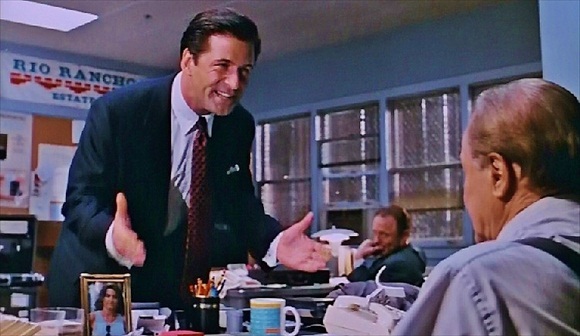 The book, On Directing Film
The book, On Directing FilmIt is ostensibly about directing, but it’s really about telling stories with pictures. This is a thing that most screenwriters have almost no idea how to do. Most screenwriters write radio plays, not screenplays. This is a visual medium. Learn to use the pictures.
It's a small book, just over 100 pages in paperback. The focus is on the weakness of most wannabe screenwriters—how to tell stories with pictures.
Here are a few quotes from the book:
Here are a few quotes from the book:
A good writer gets better only by learning to cut, to remove the ornamental, the descriptive, the narrative, and especially the deeply felt and meaningful. What remains? The story remains. What is the story? The story is the essential progression of incidents that occur to the hero in pursuit of his one goal.
The point, as Aristotle told us, is what happens to the hero... not what happens to the writer.
 |
| House of Games (1987) |
Screenwriting is a craft based on logic, It consists of the assiduous application of several very basic questions: What does the hero want? What hinders him from getting it? What happens if he does not get it?
We don't have to worry about creating a problem. We make a better movie if we worry about restoring order. Because if we worry about creating problems, our protagonist is going to do things that are interesting. We don't want him to do that. We want him to do things that are logical.
 |
| Glengarry Glen Ross (1992) |
If you listen to the way people tell stories, you will hear that they tell them cinematically. They jump from one thing to the next, and the story is moved along by the juxtaposition of images—which is to say, by the cut.
People say, "I'm standing on the corner. It's a foggy day. A bunch of people are running around crazy. Might have been the full moon. All of a sudden, a car comes up and the guy next to me says..."
If you think about it, that's a shot list: (1) a guy standing on the corner; (2) shot of fog; (3) a full moon shining above; (4) a man says, "I think people get whacky this time of year"; (5) a car approaching.
This is good filmmaking, to juxtapose images. Now you're following the story. What, you wonder, is going to happen next.
 |
| State and Main (2000) |
The work of the director is the work of constructing the shot list from the script. The work on the set is nothing. All you have to do on the set is stay awake, follow your plans, help the actors be simple, and keep your sense of humor. The film is directed in the making of the shot list. The work on the set is simply to record what has been chosen to be recorded. It is the plan that makes the movie.
We can identify with the pursuit of a goal. It's much easier to identify with that than with "character traits."
 |
| Wag the Dog (1997) |
Always do things the least interesting way, and you will make a better movie. This is my experience. Always do things the least interesting way, the most blunt way. Because then you will not stand the risk of falling afoul of the objective in the scene by being interesting, which will always bore the audience, who are collectively much smarter than you and me and have already gotten up to the punch line. How do we keep their attention? Certainly not by giving them more information but, on the contrary, by withholding information—by withholding all information except that information the absence of which would make the progress of the story incomprehensible.
 |
| Heist (2001) |
You tell the story. Don't let the protagonist tell the story. You tell the story; you direct it. We don't have to follow the protagonist around. We don't have to establish his "character." We don't need to have anybody's "back story."
If you are telling a story, then the human mind, as it's working along with you, is perceiving your thrust, both consciously and, more importantly, subconsciously. The audience members are going to go along with that story and will require neither inducement, in the form of visual extravagance, nor explanation, in the form of narration.
They want to see what's happening next. Is the guy going to get killed? Is the girl going to kiss him? Will they find the money buried in the old gold mine?
When the film is correctly designed, the subconscious and conscious are in alignment, and we need to hear what happens next. The audience is ordering the events just as the author did, so we are in touch with both his conscious and his unconscious mind. We have become involved in the story.
On Directing Film is practical, provocative, cheap to buy, easy to read. Don't miss it.
is practical, provocative, cheap to buy, easy to read. Don't miss it.
First posted: 28 April 2012

No comments:
Post a Comment